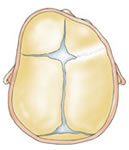On January 28th 2013 we got the word from local doctors who used an xray to confirm that Kaiya does in fact have right unilateral craniosynostosis. The local doctor said she presented with all the classic symptoms. Her right eye appears more open than her left. The right side of her forehead appears recessed compared to the left and she has a ridge going down the right side of her head. So now you ask me what is Craniosynostosis????
craniosynostosis
Definition
NOUN
1.
premature fusion of the skull sutures: a condition in which the irregular joints between the cranial bony plates fuse together, usually before birth
Now here is the description of Kaiya's type of Craniosynostosis from her surgeon Dr. Fearon's Website.
"Plagiocephaly” is the term used to describe the shape that results from craniosynostosis of either the right, or left, sides of the coronal suture. The coronal suture runs across the top of the skull extending almost from ear to ear. The soft spot, or fontanel, is located midway between the right and left coronal sutures at the top of the skull and is usually closed in children with plagiocephaly. On the side of the skull, where the suture has closed, one can often feel a raised ridge of bone. When viewed from above, the forehead on the fused side is further back than the opposite side, which typically has slightly overgrown further forward in order to compensate for the brain’s inability to grow on the side that has fused. In looking directly at the child, the eyebrow is higher on the fused side, which makes the eye seem more open. Often, it is many parents’ first impressions that it is the eye on the normal side that seems abnormally closed, when actually it is the other eye that is abnormally more open-appearing. Some may notice that their child’s nose is slightly off-center, angled or pointed towards the side of the fused suture. It is common for parents to say that their child looks worse in a mirror, which may be related to the fact that a mirror flips the image around so the right side becomes the left, etc. Instead of seeing your child as you are used to seeing him, or her, with the flatness on one side, you now see a different child with flatness on the opposite side.
The incidence of plagiocephaly is estimated to be about 1 in 3500 births. Almost all children affected with plagiocephaly require surgical treatment. Rarely, children with one coronal suture fused shut can have a gene mutation (up to 20%), which may signify a condition called Muenke syndrome.

No comments:
Post a Comment